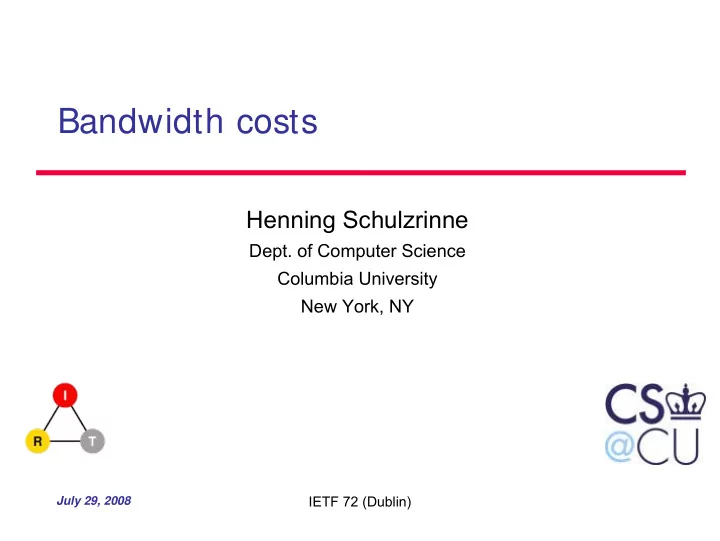

Bandwidth costs Henning Schulzrinne Dept. of Computer Science Columbia University New York, NY IETF 72 (Dublin) July 29, 2008
Overview • Video bandwidth consumption • Cost of providing video content • Economics • Mechanisms –network topology indication –scavenger service –indication of charge • Problem mainly of economics IETF 72 (Dublin) July 29, 2008
Bandwidth consumption • 4 hours/day of TV @ 18 Mb/s HDTV ➠ 972 GB/month • Columbia University caps at 350 MB/hour ≈ 252 GB/month IETF 72 (Dublin) July 29, 2008 3 3
Economics of the eco system • Long term, minimize overall cost of content delivery – across end user, provider, ISP – thus, focusing only on efficiency of HTTP misses the complete story • Components – media storage – media server bandwidth (can’t serve whole ISP from one disk) – delivery bandwidth (upstream & downstream) • Re-use of existing components vs. new components – e.g., end user DVR storage vs. dedicated cache servers – local bandwidth vs. wide-area bandwidth vs. content provider bandwidth • Allow cost allocation – e.g., rentable caches --> both content provider and ISP benefit IETF 72 (Dublin) July 29, 2008 4 4
Economics of bandwidth • Transit bandwidth $40/Mb/s/month ~ $0.125/GB • US colocation providers charge $0.30/GB to $1.75/GB – CDNs: $0.08 to $0.19/GB IETF 72 (Dublin) July 29, 2008
Cost of bandwidth • Thus, 7 GB DVD → $1.05 • HDTV viewing � $120/month for WAN bandwidth • Netflix postage cost: $0.70 round-trip • Typical PPV charges: $4/movie (7 GB) • Local bandwidth cost is amortization of infrastructure – driven by peak load, not average • Asymmetric vs. symmetric networks IETF 72 (Dublin) July 29, 2008 6 6
Cost for providing content cost across provider boundaries possibly another step when crossing oceans within campus/AS (multiple L2s) same L2 switch (non-blocking) distance within home IETF 72 (Dublin) July 29, 2008
Example: FiOS TV architecture Serving Fiber Office Fiber Serving Super Hub Office Headend Office Splitter Serving Office Super Broadcast Video Headend Voice, Data, IP TV Voice, Data, IP TV ● 2 national super headends J. Savage (Telecom ThinkTank), Nov. 2006 ● 9 video hub offices ● 292 video serving offices IETF 72 (Dublin) July 29, 2008
Verizon’s FTTP Architecture CUSTOMER PREMISE Voice & Data Downstream Voice, Data & Video 1490 OLT ONT 1490 nm nm, 1310 nm, 1550 nm Optical Optical Couplers Optical Line Splitter Optical Network (WDM) Terminal Terminal Upstream 1310 nm Video 1550 1x32 nm EDFA CENTRAL OFFICE Erbium Doped Fiber Amplifier Bandwidth & Services Upstream Downstream 1310 nm 1490 nm 1550 nm Voice & Data Voice & Data Voice, Data & VOD Voice, Data & VOD Broadcast Video Broadcast Video at 155 to 622 Mbps at 622 Mbps at 155 to 622 Mbps at 622 Mbps 54 MHz 864 MHz Analog TV Digital TV and HDTV Brian Whitton, Verizon IETF 72 (Dublin) July 29, 2008
Indication of charging • If volume-based, need application-visible charging indication – “current cost of 1 GB to 128.59.16.1 is $0.15” – “predicted cost in 3 hours is $0.05” – “you have 47.5 GB of free local traffic left” – “you are currently in penalty box” • May differ upstream vs. downstream • Applications can then prefer local content • or defer to later – “Do you want to watch the movie now ($4) or wait until 10 pm ($2.52)?” IETF 72 (Dublin) July 29, 2008 10 10
DiffServ & Bandwidth charging • Only two options: – limit supply of (high-priority) bandwidth (“1000 minutes of VoIP/month”) OR – charge for bandwidth • Probably need to differentiate “local” and “long-distance” traffic – see “free local calls” • Charging exposes user to risk – mis-behaving application or malware • need SE-Linux-like capability limitation – DoS attacks • need permission-based sending IETF 72 (Dublin) July 29, 2008 11 11
Recommend
More recommend